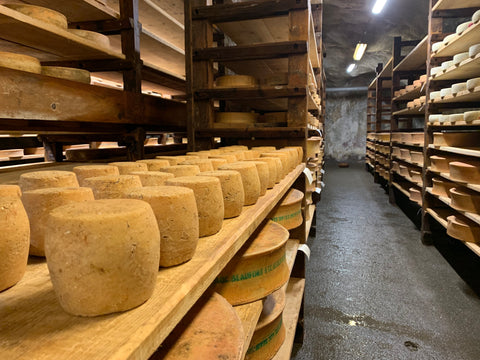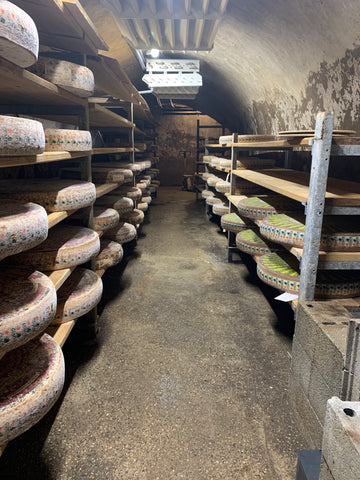REGIONAL VISIT TO SAVOIE AND FRANCHE COMTE
Introduction by Patricia Michelson
As part of our cheese life we visit cheesemakers and maturing cellars to not only choose cheese for keeping in their mountain rooms, but also to have the chance to discuss how we want our cheeses to taste. There is no better way of doing this than to have broad sweep tastings of wheels until we find batches that fit our requirements. I know it must sometimes be very frustrating for the team to have to listen to my very dictatorial explanations of what I want from a Comte and Beaufort, because for me it is vital that they are very unique in their taste, but also essentially the flagbearers of their region. Over the last few years we haven’t been able to do our usual visits due to Covid restrictions, but finally our little group of five were off on the first flight to Geneva from City Airport where we would collect a car, and drive straight to Chambery to meet Eric who matures great Beaufort cheeses and other Savoie specialities in his mountain caves as well as state of the art facility in Albertville.

As this was the first time Jakob Anderson, who started with us as a trainee cheesemonger in 2019 and then moved into the Wholesale and Warehouse site concentrating on looking after the cheese, this was an exciting opportunity for him to see at first hand how we select and why we hold some cheeses back and pitch some for using right away. The two days were jam packed and the team were exhausted at the end of it, but I was delighted with their enthusiasm, questions and general interest in what I term the La Fromagerie Thumbprint; understanding the style, taste and reasons behind our choices. I know I have been doing this for over 33 years, but it’s still thrilling to have the chance to dip into a Beaufort Chalet d’Alpage from the beginning, middle and end of a month from a year or two years ago, to see how the flavours change and develop; we can decide what we want and when we want to get it to our shops and wholesale customers. Jakob has written his diary for those few days, and here it is for you to enjoy reading, and hopefully the next time you buy a piece of Comte.
A Sum of Its Parts by Jakob Anderson
Attention to detail, appreciation for the profession, and never ending curiosity is my mind set in the work I do each day. Comte and Beaufort have and always will be pillars of our business, and for this reason it is paramount that we represent these cheeses with the utmost care and respect. We recently embarked on our annual trip to France to select our allocation of Comte and Beaufort for the next year, and I experienced at first hand the strong relationships we have built over the years with Marcel Petite, a Fruitiere in Les Fins and Les Cave d’Affineurs; all masters in their own rights.
An early morning flight to Geneva followed by a scenic journey through the Haut-Savoie brought us to Chambery and our first stop visiting Les Caves d’Affineurs where we met Eric Mainbourg to choose Beaufort Chalet d’Alpage.

Behind an ornate door with its surround of overgrown ivy is an old Ice Chamber where the Ete and Alpage cheeses are stored. Beaufort Chalet d’Alpage and Beaufort Ete are selected from a small number of farms. The Ete is made from June to October with cattle grazing on a balanced and sweet pasture in the lower valleys. The Alpage on the other hand has a very defined qualification. The milk used must be produced from cows grazing on pastures from minimum 1500m above sea level. Also the milk must be from a single herd to make the cheese. The story of La Fromagerie started with the Alpage cheese.
A ’labour of love’ does not begin to describe the process of care given to these cheeses. Each wheel is morged, this traditional way of using a rag soaked in a murky brine, salt rubbed and turned by hand. For those unfamiliar, the morge is a mixture of brine and cultures, it develops and strengthens over time as more cheeses are washed; the morge brine never changed – only topped up with a little water.
This gives a unique personality to each wheel as the millions of bacteria act on the rind. The cheeses weigh approximately 40kg and they require the washing, brushing and turning is done 3 times a week. The cheeses also benefit from the flora and naturally regulated temperature the caves provide. A living, breathing, exclusive environment ultimately displaying their true terroir.
The Alpage cheeses we selected with Eric Mainbourg, founder and director of the company, were from Alpage Mont Rosset and Bellecote Courcheval, each expressing unique profiles that we know will develop wonderfully as they age.
We then visited the tunnels that were used in the war by the military and go deep into the rockface. There are housed the tomme cheeses of different sizes and wheels of Abondance all benefiting from the natural environment.

Our next stop was the caves of Rognaix, 40 minutes east of Chambery. The cave was used after the war to store ammunition and other materials used to create hydroelectric dams around the area. After being left abandoned for several years, Eric found the location in 2011 and thought it would be the perfect place to mature the different cheeses from around the region. Over the years there have been renovations and additions to make a state of the art facility to both age and dispatch the cheese, as well as having their own shop attached to sell to locals and visitors to the area.
We spent the evening in the small town of Jougne, enjoying a lovely meal before settling in for a good night's rest, as the next day we would be turning our attention to Comte.
Over the years we have primarily worked with a Fruitiere in Les Fins and Marcel Petite. While Comte is an extremely consistent cheese, we like to offer the subtle differences these two present.
The first stop was Les Fins, very close to the town of Morteau (famous for its sausage production). This fruitiere has been making cheese since 1866 taking milk of the Montbeliarde breed from 10 different farms close by. Our Comte from this dairy have been in the 20-24 months range, sometimes ageing up to 30 months. Meaty, gamey, yet still balanced, we look for a stronger profile.
We were scheduled to meet Franck Serrete, head cheesemaker, but an unexpected birth in the company (the wife of his fellow cheesemaker going into an early labour) thrust him onto the make floor.
We were therefore guided through the cellars by Ludo, who is the shop manager at their onsite shop. We were able to taste through and select from a range of dates and chose late May 2022 and early September 2022 as our preferred cheeses. After a quick dip onto the make floor to greet Franck, we were off to Fort St Antoine.
Marcel Petite is the king of Comte. The namesake of the company reinvented the now famous cheese back in the 1960s, reverting to a slower maturing process. This defied tradition and was met with much scrutiny, Up until then Comte resembled what we would now define as Emmental. The cheeses were aged at a higher temperature and matured very fast. M. Petite experimented with a new process which saw the maturation slow down and temperature lowered, resulting in much less carbon dioxide (this results in the pockets of air primarily seen in an Emmental) inside the paste. At the time this was a highly controversial method. His cheeses were consistently disqualified from competitions as they were ‘not Comte’. However his cheeses expressed much more depth of flavour due to his new patented technique. Almost 60 years later, Marcel’s way is now the industry standard.

In 1966 Petite discovered a defunct huge miliary bunker deep inside a forest in the heart of Haut Doubs. It was used in Napoleon’s era to hide his army from sight in order to protect the frontiers to Switzerland and Italy. The fort provided optimal conditions for his slow maturing process, and starting with just 100 wheels he started to build his business. Fort St Antoine is now home to over 130,000 wheels of Comte – a cathedral of cheese.
Since then, the company has expanded with a facility in Granges Narboz a few miles south of the fort. Here an additional 150,000 Comte are stored with more focus on younger cheeses.
We were greeted by Benoit Prince, who heads up the Sales team and has been with Marcel Petite for 13 years. He has such an indepth knowledge of the company with great stories around the cheese and its history.
The scale of the caves is truly unimaginable. It’s a never ending, intoxicating onslaught of spruce boards housing cheeses floor to ceiling. There are a team of just over 100 employees that look after the cheese which, originally, were turned by hand. Today the company relies on robot machines to help with the hundreds of thousands of wheels – lifting, brushing and turning – it’s like a steady synchronized routine. The rooms all contain several different ages of cheeses, allowing for balance in the bacteria. Benoit described the cheeses as fruits, with delicate rinds needing constant attention to give their unique flavours and profiles.
We met Jose, the Maitre de Cave, who guided us through our allocation for the coming year. His job is to care, manage and taste all of the Comte on the premises. He knows these cheeses better than anyone. Watching him navigate age profiles on memory inside a dizzying maze of aisles was truly impressive. We were able to select our three profiles for the year 18, 24 and 30 months and we all made notes as we tasted through the cheeses.
Marcel Petite work with over 35 Fruitieres throughout the region, but we have consistently chosen wheels from one over the years. Fruitiere Valoielle have been the Comte of choice for our shops; expressing cheeses higher in fruit and floral flavours. However, Jose re-introduced us to Fruitiere Belleherbe, who we worked with many moons ago. With profiles that are meatier and more full on, we decided this would be something that could complement the Valoielle cheeses. An interesting juxtaposition between style and power. Both have their place.
With our Comte sorted it was now time to return to London, but not before a fitting French feast to end our trip. Comte, baguette, braised pork and rice, and of course a bottle or two of local wine. It was French hospitality flowing through the veins of Fort St Antoine, and we could not have finished our short visit better.

